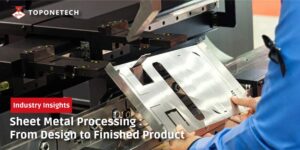
Sheet metal processing is a vital part of manufacturing across various industries, from automotive to aerospace, electronics, construction, and beyond. Furthermore, its versatility, durability, and cost-effectiveness make it a popular choice for creating a wide range of products. In this comprehensive guide, we’ll walk you through the entire process of sheet metal processing, from initial design considerations to the finished product.
1. Design and Planning
The journey of sheet metal processing begins with meticulous planning and design. Engineers and designers collaborate to conceptualize the product, considering factors such as functionality, material choice, and manufacturing feasibility. Computer-Aided Design (CAD) software is often employed to create precise blueprints and 3D models.
Key considerations during the design phase include:
- Material Selection: The choice of material depends on factors like strength, corrosion resistance, and cost. Furthermore, common materials for sheet metal processing include steel, aluminum, stainless steel, and copper.
- Thickness: The thickness of the sheet metal affects the strength and flexibility of the final product. Therefore, it’s crucial to select the appropriate gauge based on the intended application.
- Tolerances: Designers must specify tolerances to ensure dimensional accuracy during fabrication. Additionally, tighter tolerances may require more advanced manufacturing techniques.
2. Cutting
Once the design is finalized, the sheet metal is ready for cutting. Several methods are available for cutting sheet metal, including:
- Shearing: Shearing involves cutting straight lines on flat sheet metal using a shear or similar cutting tool. Moreover, it’s suitable for simple shapes and high-volume production.
- Laser Cutting: Laser cutting utilizes a focused laser beam to melt, burn, or vaporize the material along a predefined path. Additionally, it offers high precision and versatility for complex shapes.
- Waterjet Cutting: Waterjet cutting uses a high-pressure stream of water mixed with abrasive particles to cut through sheet metal. Furthermore, it’s ideal for materials that are sensitive to heat or require intricate detailing.
3. Bending and Forming
Bending and forming operations shape the flat sheet metal into the desired 3D geometry. This process typically involves:
- Press Brake: A press brake applies force to bend the sheet metal along a straight axis. Additionally, V-dies and punch tools create various bend angles and shapes.
- Roll Forming: Roll forming passes the sheet metal through a series of rollers to gradually bend it into a curved or cylindrical shape. Moreover, it’s commonly used for producing tubes, channels, and complex profiles.
- Stamping: Stamping presses use dies to deform the sheet metal into specific shapes through bending, stretching, or deep drawing. It’s suitable for high-volume production of consistent parts.
4. Joining
Joining methods are employed to assemble multiple sheet metal components into a single structure. Common joining techniques include:
- Welding: Welding fuses metal parts together using heat and pressure. Processes such as MIG, TIG, and spot welding are commonly used in sheet metal fabrication.
- Fastening: Fasteners like screws, rivets, and bolts are used to mechanically join sheet metal components. They provide strength and allow for disassembly and reassembly.
- Adhesive Bonding: Adhesives create a strong bond between metal surfaces without the need for heat or mechanical force. They’re useful for joining dissimilar materials or complex shapes.
5. Finishing
After fabrication, sheet metal products often undergo finishing processes to enhance their appearance, durability, and functionality. Finishing options include:
- Surface Treatment: Surface treatments like painting, powder coating, and anodizing protect the metal from corrosion and improve its aesthetic appeal.
- Deburring: Deburring removes sharp edges and burrs from the edges of cut or formed sheet metal parts, ensuring safety and smooth functionality.
- Polishing and Buffing: Polishing and buffing processes create a smooth, reflective surface finish, enhancing the appearance of the product.
6. Quality Control
Quality control is essential throughout the sheet metal processing workflow to ensure that finished products meet design specifications and performance requirements. Inspectors employ techniques such as dimensional measurement, visual inspection, and material testing to detect defects and deviations.
7. Assembly and Packaging
The manufacturing team finally packages and prepares assembled sheet metal components for shipment to customers or assembly lines. Careful packaging protects the finished products from damage during transit and storage, ensuring they reach their destination in pristine condition.
In conclusion, sheet metal processing is a complex yet rewarding endeavor that requires careful planning, precision, and attention to detail at every step of the way. Furthermore, by understanding the intricacies of design, cutting, bending, joining, finishing, quality control, and assembly, manufacturers can produce high-quality sheet metal products that meet the needs of diverse industries and applications.
We can customize various types of sheet metal products, specially designed certainly for your application scenarios!
Contact us for further information :
Whatsapp/Call us at : +86 13631610695
Email : sales@toponetechmetal.com



